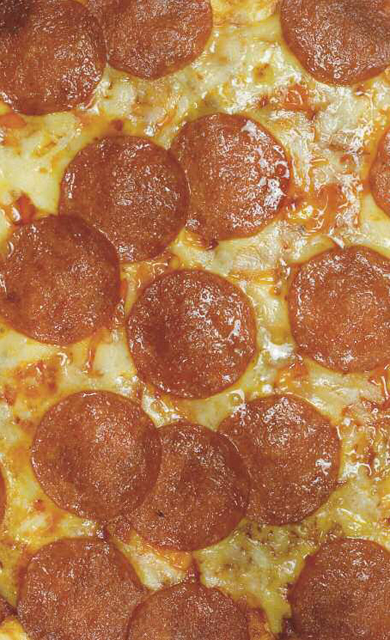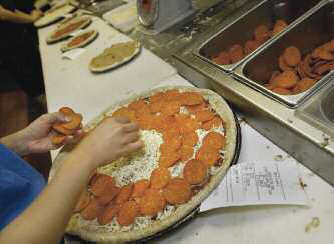Helstosky - Pizza: a global history
Here you can read online Helstosky - Pizza: a global history full text of the book (entire story) in english for free. Download pdf and epub, get meaning, cover and reviews about this ebook. City: London, year: 2008, publisher: Reaktion Books, genre: Home and family. Description of the work, (preface) as well as reviews are available. Best literature library LitArk.com created for fans of good reading and offers a wide selection of genres:
Romance novel
Science fiction
Adventure
Detective
Science
History
Home and family
Prose
Art
Politics
Computer
Non-fiction
Religion
Business
Children
Humor
Choose a favorite category and find really read worthwhile books. Enjoy immersion in the world of imagination, feel the emotions of the characters or learn something new for yourself, make an fascinating discovery.
- Book:Pizza: a global history
- Author:
- Publisher:Reaktion Books
- Genre:
- Year:2008
- City:London
- Rating:4 / 5
- Favourites:Add to favourites
- Your mark:
- 80
- 1
- 2
- 3
- 4
- 5
Pizza: a global history: summary, description and annotation
We offer to read an annotation, description, summary or preface (depends on what the author of the book "Pizza: a global history" wrote himself). If you haven't found the necessary information about the book — write in the comments, we will try to find it.
Pizza: a global history — read online for free the complete book (whole text) full work
Below is the text of the book, divided by pages. System saving the place of the last page read, allows you to conveniently read the book "Pizza: a global history" online for free, without having to search again every time where you left off. Put a bookmark, and you can go to the page where you finished reading at any time.
Font size:
Interval:
Bookmark:


Series Editor: Andrew F. Smith
EDIBLE is a revolutionary new series of books dedicated to food and drink that explores the rich history of cuisine. Each book reveals the global history and culture of one type of food or beverage.
Already published
Hamburger Andrew F. Smith
Pancake Ken Albala
Forthcoming
Spices Fred Czarra
Pie Janet Clarkson
Beer Peter La France
Cake Nicola Humble
Caviar Nicola Fletcher
Chocolate Sarah Moss
Cocktails Joseph M. Carlin
Curry Colleen Taylor Sen
Fish and Chips Panikos Panayi
Hot Dog Bruce Kraig
Lobster Elisabeth Townsend
Tea Helen Saberi
Tomato Deborah A. Duchon
A Global History
Carol Helstosky
REAKTION BOOKS
For Helen
Published by Reaktion Books Ltd
33 Great Sutton Street
London EC1V 0DX, UK
www.reaktionbooks.co.uk
First published 2008
Copyright Carol Helstosky 2008
All rights reserved
No part of this publication may be reproduced, stored in a retrieval
system, or transmitted, in any form or by any means, electronic,
mechanical, photocopying, recording or otherwise, without the prior
permission of the publishers.
Page references in the Photo Acknowledgements and
Index match the printed edition of this book.
Printed and bound in China by C&C Offset Printing Co., Ltd
British Library Cataloguing in Publication Data
Helstosky, Carol
Pizza : a global history. (Edible)
1. Pizza 2. Pizza History
I. Title
641.824809
eISBN: 9781861896308
Pizza alla casalinga, from ITALIAN FOOD by Elizabeth David, copyright 1954, 1963,
1969, 1977, 1987 by Elizabeth David. Used by permission of Penguin, a division of
Penguin Group (USA) Inc.
Rustic Pizza: From THE TALISMAN ITALIAN COOKBOOK by Ada Boni, copyright 1950
by Crown Publishers, Inc. Used by permission of Crown Publishers, a division of
Random House, Inc.


In 1835, French author, travel writer, and culinary expert Alexandre Dumas travelled to Naples, Italy where he observed the customs and life of the Neapolitan poor. His published work, Le Corricolo (1843), described the infamous lazzaroni of the city, so named because their ragged appearance evoked images of Lazarus. Dumas declared that the lazzaroni subsisted on two foods: watermelon in the summer and pizza in the winter. In describing pizza for his readers Dumas wrote that, at first, it appeared to be a very simple thing: the poor and the working classes ate flatbread with various toppings for breakfast, lunch or dinner. Pizza was a kind of bread, but it was not purchased whole; rather, customers bought the size they could afford. There were also many varieties of pizza for sale: pizza with oil, pizza with lard, pizza with tomatoes, pizza with tiny fish, pizza with cheese. The variety and popularity of toppings told Dumas more than just what the lazzaroni liked. The ingredients of a pizza told him about the cost and availability of certain foods in Naples. In turn, the cost and availability of certain foods told him about the status of a particular harvest or the health of the local economy. Thus, pizza was more than an example of a regional culinary curiosity, it was the gastronomic thermometer of the market and therefore of Neapolitan society. Upon further reflection, Dumas wrote, pizza was not so simple a food; it was actually quite complicated in that it told us as much about the society that ate the pizza as it did about the pizza itself.
Pizza is a simple food; many of us eat it without even thinking about it. Frequently, lets have a pizza is the automatic response when a group of friends, workers or family members are trying to decide what to eat for dinner or lunch or a snack. Some of its fans eat pizza several times a week or even every day. What was once the mainstay of the urban poor in Naples has become the worlds most popular fast food and millions of people around the world eat pizza because it is uncomplicated and readily available. However, as Dumas observed, pizza is more complicated if you think about it long enough. As the popularity of pizza spread from Naples to the rest of the world, it changed, sometimes dramatically, in terms of shape and flavour. As it moved into different societies, pizza came to mean different things to different people, taking on more significance than a simple snack perhaps ought to have. For Neapolitans, pizza was a way to survive but it later became part of the citys mythic history. For the rest of Italy, pizza became an adopted favourite meal, representing a part of Italian cuisine to be celebrated, commemorated and protected. For Italian emigrants, pizza became a way to connect back to ones homeland as well as a way to earn a living. And for non-Italians, pizza was both an ethnic food and a blank canvas, open to all forms of culinary experimentation. As new groups of people embraced pizza, they adapted it to suit their own tastes or ideas about a good meal or snack. Although it was frequently introduced to people as a typical Italian food, pizza became the gastronomic thermometer of the markets of the world, incorporating such unlikely ingredients as mustard, kiwi fruit and barbecued chicken. Today, some prefer the traditional pizza margherita with tomatoes, mozzarella and basil while others indulge in pizza topped with sweetcorn, tuna, mushrooms, onions and capers.
This book takes a simple food like pizza and makes it more complex by describing the many things that people have done to pizza over the course of the last 200 or so years. Chapter One describes how and why pizza became one of the most popular foods in eighteenth- and nineteenth-century Naples and then spread to the rest of Italy in the twentieth century. As pizza became more popular it became more respected by Italians outside Naples. Critics first viewed pizza as vile food for the poor and reported that pizzerias attracted shiftless youth who wasted entire afternoons either devouring pizzas or wishing they had the money to purchase and devour pizzas. Pizza remained a local speciality until well after World War II and then migration and tourism made pizza the culinary heritage of all Italians southern, northern, rich, poor, young and old. Not surprisingly, pizza garnered more respect from Italian gourmets in these years, so much so that a movement started to protect authentic Neapolitan pizza from the dangers of standardization and extinction. The urge to protect traditional pizza as a way to preserve some aspect of the Italian past coexists, however uneasily, with more creative approaches to making and eating pizza, as Italians continue to celebrate what has become one of their most important culinary gifts to the world.

A pepperoni pizza is made to order.
Although Italians lay claim to the invention of pizza as a combination of bread, tomatoes and cheese, the food found its second home in the United States. Arguably, pizza went from being strictly Neapolitan to being Italian-American and then becoming Italian. Chapter Two examines the history of pizza in the United States, following the pathways of Neapolitan immigrants through cities like New York, Boston and New Haven, Connecticut. And, just like in Italy, pizza broke out of a local enclave and became popular with the general population after World War II. Americans applied generous amounts of technology and entrepreneurial skill to producing and selling pizzas after the war and this accounted for the foods growing popularity, yet it also meant that pizza lost some of its ethnic character. Although corporate and advertising executives struggled to represent pizza as a humble food, there was no disguising the fact that pizza production became a multi-million dollar industry within a few short decades. Pizza became embedded in the national consciousness, whether as the subject of childrens literature, the staple of university and college students or the background for a scene from a Hollywood film. In the United States, pizza has become more than an ethnic food representing Italy; it has become everything from haute cuisine to a nostalgic comfort food, from addictive substance to a family staple. It is estimated that Americans eat about 100 acres of pizza a day or 350 slices per second. Broken down, that means that every man, woman and child in the United States eats 46 slices of pizza a year. The American love for pizza rivals that of the Italians, but, as chapter Two demonstrates, the two populations have taken pizza in divergent directions and thus pizza has a different historical and economic resonance in the United States.
Font size:
Interval:
Bookmark:
Similar books «Pizza: a global history»
Look at similar books to Pizza: a global history. We have selected literature similar in name and meaning in the hope of providing readers with more options to find new, interesting, not yet read works.
Discussion, reviews of the book Pizza: a global history and just readers' own opinions. Leave your comments, write what you think about the work, its meaning or the main characters. Specify what exactly you liked and what you didn't like, and why you think so.









